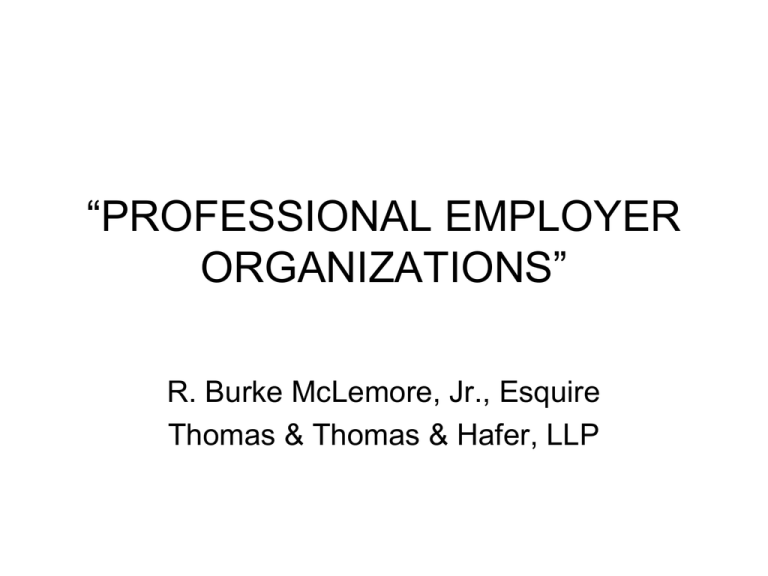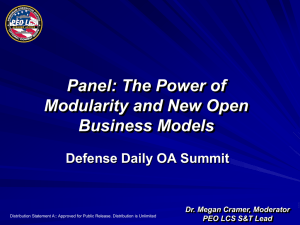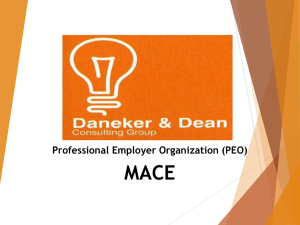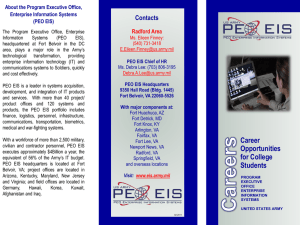McLemore PPT - National Council of Self Insurers
advertisement

“PROFESSIONAL EMPLOYER ORGANIZATIONS” R. Burke McLemore, Jr., Esquire Thomas & Thomas & Hafer, LLP IMAGINE…. • You own a small business, 18-20 employees • “Killer” workers’ compensation premiums • High unemployment compensation rates • Several different types of employees: office employees, production employees, and delivery drivers • Next year, workers’ compensation premiums will increase dramatically The Genie “In today’s competitive market, only the smart leader sees profit margins climbing. You realize that one of the largest problems facing your business is balancing cost against having an effective staff. Using concepts tried and proven by some of today’s leaders and most profitable companies, I can help to stabilize your costs and insulate you from unexpected increases, which can send your profit margins tumbling.” The First Year • Everything is great! • Costs have dropped • Everything the genie said would happen is coming true…..... • But then……… • PEO fails to make payments of unemployment compensation and health insurance premiums for “its employees” • PEO gets dropped by “its” workers’ comp carrier • One of your drivers suffers a catastrophic injury in a truck accident • PEO gets into litigation with its prior carrier over cancellation of the policy • PEO disappears or goes into bankruptcy • The owners – just like the genie of the bottle – are untraceable Now……. • You have no coverage • Entire loss falls on you • Petition filed against you for benefits owed AND for penalties for failing to maintain proper workers’ compensation insurance • Criminal prosecution for failing to comply with workers’ compensation laws • Audit and fine for unemployment compensation premiums • Suit in tort by the injured Claimant, but no coverage • Employees end up with no workers’ compensation coverage and no health insurance benefits • You lose your entire business and go bankrupt How is this relevant to you, self-insureds? • Some of you are already contracting with PEOs • Some are dealing with PEOs and don’t even know it • When PEO defaults and loss falls upon the uninsured employer, who do you think is the next in line to pay? • Potentially, it is you as a statutory employer • You may be statutorily bound to provide coverage for persons that you have no contractual relationship with whatsoever WHAT IS A “PEO” AND HOW DOES IT OPERATE? • Entity that provides employers with administrative services such as payroll, employee benefits, tax management and workers’ compensation coverage • PEO considered the “administrative” employer • “Actual” employer continues to exercise all control • Establishes a contractual relationship for: - payroll administration, including payment of wages and employment taxes - tax reporting, including preparing and filing records, collecting taxes due - creating a co-employment situation by establishing and maintaining and employment relationship with the actual employer’s employees • PEOs are not “labor brokers” • Rarely, if ever, do PEOs assume any responsibility or control over an employee’s work, workplace, or safety • PEO model is based on the concept of cost consolidation • Quality of PEOs varies widely • Often focus their marketing on employers with high workers’ compensation costs. • Often create a “pool” of clients based upon adverse selection • Not a “cream skimmer” situation! • Some engage in “Unemployment Compensation dumping” HOW PREVALENT ARE PEOs AND WHY ARE THEY POPULAR? • Popularity of employee leasing and explosive growth in the industry results from two factors: – benefits costs and – complexity of administration and regulatory compliance. • National Association of Professional Employer Organizations (NAPEO) indicates there are now at least 700 PEOs operating in the United States. In 2010, revenues increased by $10 billing to $81 billing • Huge segment of the labor market • “Contingent workforce” has grown approximately 75% faster than overall workforce • Businesses are not equipped to handle onslaught of regulations and regulators – burden particularly onerous on small business • FMLA Act • National Labor Relations Act • Cheaper workers’ compensation coverage • PEOs may actually try to make additional profit by establishing a “retro plan” – which may have beneficent effect of encouraging PEOs to police their clients’ risks, encourage safety and eschew partnering with risky businesses • By pooling risks, employee leasing company or PEO may have thousands of employees working at several hundred client companies HOW DO PEOs DEFINE AND MARKET THEMSELVES? • NAPEO alone lists well over 350 members • “With employee paperwork headaches out of the way, businesses can concentrate their efforts on doing the things they do best and on growing their business” • NAPEO touts “co-employer relationship” with PEO clients: contractual allocation and sharing of employer responsibilities between the PEO and the client. • “Value” provided by PEOs: – Relief from the burden of employment administration – Wide range of personnel management solutions through a team of professionals – Improved employment practices, compliance and risk management to reduce liabilities – Access to a comprehensive employee benefits packages, allowing clients to be competitive in the labor market; – Assistance to improve productivity and profitability • Favorable spinoff to the government as well: – Aggregates dozens of small clients and takes care of tax payments – Potential for increased compliance with employment law requirements – Group purchasing power for health insurance and other benefits – Improved worker safety – Some large enough to provide 401K plans HOW DOES THE PEO OPERATE? • Written agreement with their clients • Worker is considered an employee of the PEO • “Actual employer” oftentimes treated like a borrowing or special employer – Entitled to traditional workers’ compensation immunity from suit by the “employee” • “Actual employer” is not really seeking temporary labor services but is seeking to shift the risk of loss for its permanent workforce • Client is “outsourcing” all of its personnel and then leasing them back THE TYPICAL PEO AGREEMENT • Initial term of 30 days, automatically renewing for 30 day term • Client is obligated to furnish to the PEO a list of employees • No employee shall be employed by the PEO or entitled to any benefits or workers’ compensation coverage unless the “employee” has completed an I-9 form, an Employment Application, withholding forms and until the client receives confirmation from the PEO that the employee has been “hired” • Actual employer is obligated to provide accurate wage information • Barring full compliance, the Agreement normally places all liability for any benefits or damages back on the client • The Agreement normally provides that the actual employer shall maintain all right of control for the day to day work activities of the employee, and that the PEO retains no right of control • “Client shall have sole and exclusive control over the day to day job duties of all leased employees and PEO shall have no responsibilities with regard to the leased employee’s performance of day to day job duties. Furthermore, PEO shall have no control over the job site at which, or from which, leased employees perform their services. Control over the day to day job duties of leased employees and over the job site at which or from which leased employees perform their services is solely and exclusively assigned to client. Client expressly absolves PEO of control over the day to day job duties of the leased employees and over the job site at which, or from which, leased employees perform their services.” • Standard Agreement requires PEO to secure workers’ compensation coverage “in such amounts as is required by applicable law” • Claim management may be done in house, or through a TPA • PEO “shall” provide proof of insurance coverage to client • If policy is cancelled, notice must be given within so many days prior to termination date • Cross-indemnification provisions • Personal guaranty of the client or its officers PROBLEMS WITH THE RATING PROCESS/RATING AND COVERAGE CHALLENGES • Major challenges in the insurance realm for regulators anxious to promote proper risk classification and experience ratings • Non-capitalized entity nominally employing a whole variety of employees • Clients of PEO laboring in varying unrelated enterprises in multitude of jurisdictions • When “client” joins or leaves a PEO, how is its and/or the PEOs experience rating appropriately calculated? • Public construction contracts require that the contractors provide proof of insurance • Demonstrating proper comp coverage is normally straightforward….. • But when business has outsourced not only its insurance responsibility but also its employees, how can this task reasonable be accomplished? • Several Factors of Concern: – Distorted experience ratings – When a PEO contracts with another PEO, carrier may not know who they are underwriting – Can the PEO self insure? – How do you rate a master policy? – What happens to the employees if the actual employer fails to notify the PEO about the hiring? – Does the client really know who the “carrier” is? – Is the carrier even licensed to write in the state? • When all goes well, these issues never arise…. • But…..Injured workers with bona fide or undisputed claims – but no employer or carrier willing to voluntarily accept liability or even acknowledge employee status – cause genuine problems • Employers who thought (incorrectly) that they had coverage through a PEO appear at compensation hearings, often unrepresented, and admit they have no independent means of paying their workers’ compensation claims • Employees sue their employer in tort cases and personal injury actions, resulting in essentially, “no fault” judgments against the employer • Declaratory judgment actions arise over coverage and cancellation of policies • Courts are presented with increasing number of insurance coverage disputes arise out of employee leasing • Are carriers of employee leasing firms are responsible under Part 2 of the standard policy to defend and potentially indemnity an employer when the employee has collected under Part 1 of the policy? • Does the standard Comprehensive General Liability (CGL) policy legitimately exclude coverage for claims made by leased employees? • In states that have procedures like supersedeas funds or which finance their workers’ compensation programs through a percentage of premium dollars, those who have proper coverage – whether through self insurance or otherwise – end up “taking the hit” DEALING WITH FRADULENT CLIENTS AND PEOs • Problems can occur with the client of the PEO: • Example – Claimant lost four fingers on the first day of work with the client before he was recorded on the payroll and before his employment application had been received by the PEO. PEO and carrier denied the claim as “not an employee” – PEO relied on contract provision: “must be on the payroll” to be employee • Court upholds contract: “Employee leasing enterprises can be the target of workers’ compensation fraud by client companies who might conceal workers from the leasing company to avoid a leasing charge for that person” • PEO standard contract with client contained a provision that no one would be considered an “employee” until: (1) the person completed and signed all pages of the hiring packet (2) the PEO gave written approval for that person to be hired As such, the client, not the PEO, was responsible for the injured employee. Other methods clients defraud PEOs: • By using the easy trick of under-reporting the number of employees. • Using fake or substitute job titles of actual workers • Paying wages directly to the employee, thereby avoiding fees to the PEO • Underreporting of payroll can also be a device used by the PEO to make a profit • The Clancy case: – Employees received two checks: one for what Clancy called W-2 wages, another referred to as “dividend” – Clancy failed to disclose the amount of the so-called “dividend” paid to each employee to the state fund – Dividend usually amounted to more than ½ of the employee’s income – Clancy claimed to clients and prospects that he could reduce their premiums by 50% and provide complete workers’ compensation coverage through the California State Fund – …..it cost him $14.6 million….. • Potential fraud can occur when a group of similar companies with an intent to defraud, establish a proprietary leasing firm and transfer all of their existing employees to that firm in an effort to use it as a “front” to disguise their own operations: – Used to avoid experience modification surcharges – To hide misclassification of job duties HOW HAVE PEOs BEEN STATUTORILY REGULATED? • Several states have established PEO licensing divisions. • In order to become licensed, the “controlling person” must meet certain criteria • Leasing agreement must show that the PEO is responsible for: – Maintaining accounting and employment records – Reserving some right of direction and control over leased employees – Assuming responsibility for payment of wages to the leased employees without regard to payment by the client of the leasing company – Assuming full responsibility for payroll taxes and collection of taxes – Retaining authority to hire, terminate, discipline and reassign the leased employees – Performing (or having performed) safety inspections – Promulgating and administering employment and safety policies – Managing workers’ compensation claims – Giving written notice of the relationship between the employee leasing company and the client company to each leased employee – Retaining a right of direction and control over management of safety, risk and hazard control at the work site • PEO shall be responsible for providing workers’ compensation coverage “as required by law” • Bond or irrevocable letter of credit typically required IMMUNITY FROM SUIT AND RECOVERY FROM THE CORRECT “POCKET” • The employer who has right to control the employee enjoys statutory immunity from suit • PEO typically eschews any right to control the employee’s activities • Problems can clearly arise, however, when neither client nor PEO secures the coverage necessary to protect against workers’ compensation claims. • Employee can attempt to sue the PEO for failing to police the workplace, etc. • Statutory employer provisions of the typical Workers’ Compensation Act – Injured employee simply works his way “up the chain” to the statutory employer • Crucial to know whether your contractors and their subcontractors have in fact secured coverage for workers’ compensation and whether they are utilizing the services of PEO employees • Uninsured client who has not contracted with an insurer or a legitimately selfinsured PEO may be sued by the employee in tort. – Typically “strict liability” • Insurance coverage outside the realm of workers’ compensation is an important part of the concern. – Occidental Fire and Casualty – Employer sought coverage under its CGL policy; actual employer’s liability insurance specifically excluded coverage for erstwhile workers’ compensation claims. – Employer/client had no coverage at all • When PEO defaults, remedy in suit against the PEO: • John T. Gallaher Timber Transfer v. Robert Hamilton – primary employer was responsible to reimburse the statutory employer • Tri-Union Express v. WCAB – Estoppel theory to require that the leasing company be bound to provide coverage: Bound by promises to provide coverage irrespective of their statutory obligation to do so • American Insurance Company v. WCAB – “[b]ecause Truck Services obtained and paid for a workers’ compensation policy and led the Claimant to believe that the policy coverage was in effect, Truck Services cannot contend that an employer/employee relationship does not exist between it and the Claimant”. STAYING PROTECTED • Some of the potential problems receive statutory treatment or statutory protection. • In most cases, however, the answer is that there is no statutory remedy. • “Best Practices”: – Verify the requirements of state law – Document the terms of the relationship carefully – Verify the rate classifications for your employees – Know your PEO – Get references and check them out thoroughly – Get to know the principals of the PEO – Know the PEO’s corporate structure – Make sure that if any licenses are required by the PEO, the licensing has been obtained and is current – Verify the insurance, particularly the workers’ compensation coverage • Have your company named as an additional named insured • Insist that notification of any policy cancellation be given to you no later than 30 days prior to cancellation • Verify that the workers’ compensation carrier for the PEO is licensed to do business in the states in which you operate • Verify that the PEO is making payments on payroll related taxes, unemployment compensation and the like • Make sure that a bond or irrevocable letter of credit is in place • Avoid signing a “standard” boilerplate contract agreement WRAP UP • Protect yourself in advance and avoid the “after market” risks of leased employees • Risk shifting and similar schemes have a cost • “There is no such thing as a free lunch” • And remember: There is no magic genie, either!







